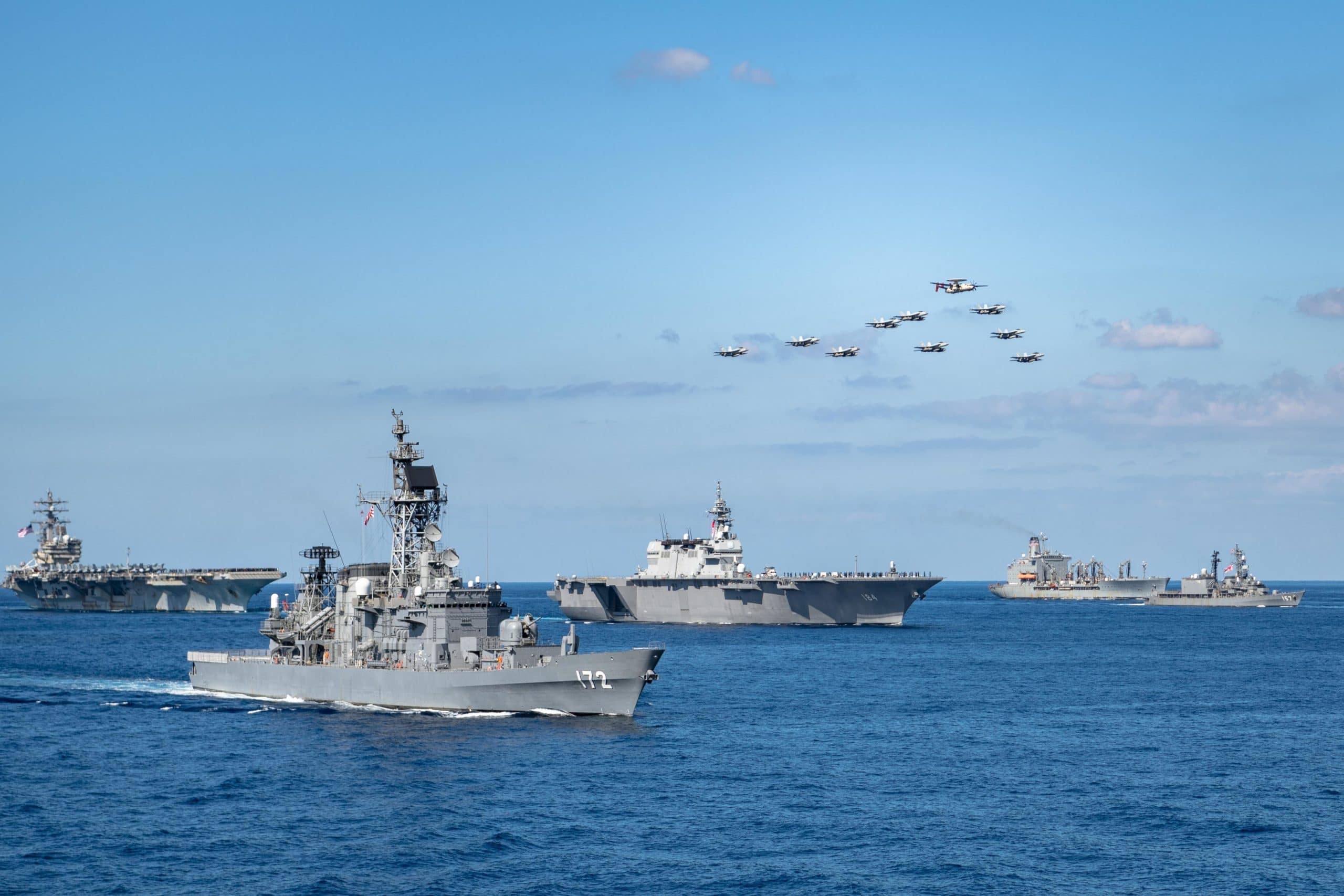December 15, 2020 | Defending Forward Monograph
Seizing the Advantage in the Asia-Pacific
December 15, 2020 | Defending Forward Monograph
Seizing the Advantage in the Asia-Pacific
Today’s military balance in the Western Pacific is the product of China’s successful 25-year effort to build a military capability that specifically targets and holds at risk U.S. air and maritime forces.1 Since the Taiwan Strait crisis of the mid-1990s, China has worked diligently to exploit vulnerabilities in U.S. forces and mitigate U.S. strengths. China’s geography, strategy, and military systems place U.S. military forces – and the American interests they defend – at significant risk.2 There is reason to believe that Beijing could successfully launch a lightning attack that would seize a strategic advantage or objective.3 This, in turn, would force Washington either to accept the result of an attempted fait accompli or to engage in a high-risk military conflict to dislodge PLA forces.
To avoid this scenario and protect vital economic and national security interests, the United States – along with regional allies and partners – must undertake a series of military posture shifts, doctrinal developments, and capability investments.
At the outset of the Cold War in the late 1940s and early 1950s, Washington established new security alliances and built a system of global military bases. Reflecting a strategic consensus regarding the need for forward defense, these bases were designed to defend American interests by stationing significant sea, air, and land power in both Europe and Asia. Beginning in the 1970s, for various political and diplomatic reasons, Washington slowly shifted U.S. military posture out of bases in South Vietnam and Thailand (1975), Taiwan (1979), and the Philippines (1991) and consolidated in Northeast Asia (Japan and South Korea), where the majority of U.S. forces have been since the 1990s. For the first two decades of China’s modernization effort (1994 to 2012), U.S. force posture in Asia remained largely stagnant.

U.S. Navy ships assigned to the USS Ronald Reagan Carrier Strike Group joined ships of the Japan Maritime Self-Defense Force (JMSDF) and the Royal Canadian Navy in formation while aircraft from the U.S. Navy, U.S. Marine Corps, U.S. Air Force, JMSDF, and the Japan Air Self-Defense Force fly in formation during Keen Sword 21. (Photo via U.S. Navy Lieutenant Junior Grade Samuel Hardgrove)
Starting in 2012, the Obama administration pursued a modest effort to modernize and reposition U.S. forces in Asia. The goal was to develop a new posture that was “geographically dispersed, operationally resilient, and politically sustainable.”4 This meant reinforcing capabilities in Northeast Asia and establishing new capabilities in Southeast Asia.
These changes included transitioning to a more capable nuclear-powered aircraft carrier forward-stationed in Japan and modernizing its embarked carrier air wing.5 The United States also stationed two extra destroyers and a squadron of fifth-generation fighters in Japan,6 an additional submarine and THAAD missile battery in Guam and South Korea,7 and rotational Littoral Combat Ships in Singapore.8 Washington further inked a new defense cooperation agreement with the Philippines and established a persistent Air Force and Marine Corps presence in Australia.9
These efforts provided opportunities to construct a sustainable posture at new and relevant locations in the theater. Some efforts made direct operational contributions, particularly the U.S. Air Force initiatives in Northern Australia.10 Others, such as the Marine Corps training initiative in Australia and rotational Littoral Combat Ships in Singapore, focused more on training and reassuring allies and partners but did little to add combat power or counter Chinese forces.
In short, while the U.S. military has started to improve its physical infrastructure and military capabilities in the theater, the somewhat languid pace of change, combined with Chinese force modernization and growth, has contributed to a continuing dangerous shift in the military balance of power.
Going forward, the United States must establish sufficient forces and capabilities in the theater to deter aggression and enable sufficient surge forces to arrive in a timely manner should deterrence fail. There are a number of steps the United States should undertake without delay.
The Pentagon should start by making China the explicit priority in the next National Defense Strategy (NDS). The 2018 NDS determined that the “long-term strategic competitions with China and Russia are the principal priorities for the Department.”11 While both countries threaten U.S. interests, the long-term economic and military challenge posed by China exceeds that of Russia.12 The next NDS should clearly state this.13 Operational planners, logisticians, and weapon system developers will all take their cues from the NDS.
The Pentagon must also press its undersea warfare advantage. One of the remaining areas of U.S. asymmetric advantage against China is America’s attack submarine force. The U.S. Navy boasts the most capable attack submarines in the world, but the fleet is too small and growing smaller. The fleet is projected to decline from 51 today to a low of 42 in 2027, leaving the Navy with 24 fewer submarines than required by operational plans.14 To correct this growing deficit, the Pentagon should ensure that as many Los Angeles-class attack submarines receive service life extensions as is feasible. The Navy must also gradually raise and maintain the new attack submarine construction build rate to three per year. Additionally, the Navy also needs to continue to reposition submarines to the Pacific, including by basing new Virginia-class submarines in San Diego and Hawaii and basing a fifth, and eventually sixth, submarine in Guam. Going forward, Congress must prioritize investment in America’s undersea warfare infrastructure: attack submarines, ocean surveillance systems, and unmanned undersea vehicles.
In response to the growing threat from the PLA, the Department of Defense must also shift toward a distributed and more lethal airpower posture. China’s efforts to threaten U.S. and allied airfields and logistics facilities with large numbers of modern cruise and ballistic missiles places U.S. air superiority at risk. To address this threat, the United States must be able to rapidly adjust its in-theater airpower and develop operational concepts that generate maximum combat power from an increasingly resilient architecture. Washington should prioritize new airfield investments 1) on forward U.S. territory, including Guam, Palau, Yap, Tinian, and Saipan; 2) on existing bases in Japan; and 3) on sites where the United States may gain access, including in Australia, Singapore, and the Philippines.
In Japan, the U.S. military should consider repositioning strike fighters currently at Kadena Air Force Base in Okinawa to bases in northern Japan. Doing so would distribute strike power and move some strike fighters farther out of range of the majority of China’s short- and medium-range missiles.
Additionally, the joint force should improve its fifth-generation capability in the Pacific, place U.S. Air Force F-35s in Misawa, and place ground detachments of U.S. Navy E-2D aircraft in Guam and Japan. In addition, the U.S. National Guard squadron of F-22s currently in Hawaii should be transferred into the active Air Force and moved to Alaska, Guam, or northern Japan to enhance readiness. Finally, the United States should invest in cruise missile defense systems (the Army can no longer effectively defend against the full spectrum of cruise missiles) and should forward station portable “deployable airbase systems” throughout the theater. This should include fixed integrated air and missile defense to leverage current advanced sensor systems.
The U.S. military also needs to restore its strike system proximity, increase its access to the theater, and improve the capability and availability of munitions pre-positioned there. The primary focus should be a strategy of deterrence by denial in the maritime domain through the deployment of overlapping anti-ship and land-attack missile networks. This requires an emphasis on permanently deploying systems that can operate inside the theater, starting with long-range bombers (operated from Guam, Australia, and potentially Alaska in the future).
Second, the United States should seek to rotate large quantities of mobile ground-based strike systems that can place Chinese maritime and land targets at risk with conventional weapons across the first island chain.15 These systems could be maintained in the theater in Guam and then rotated on a regularly basis throughout locations in Japan, the Philippines, Australia, and elsewhere if the host nations can be persuaded that such an initiative supports mutual interests.
Finally, this effort will require survivable maritime strike systems, both inside the first island chain (such as unmanned surface and subsurface systems with strike payloads) and outside the first island chain (carriers with long-range unmanned strike platforms). These systems should be paired with a resilient, survivable space-based surveillance and targeting system. This sensor-platform-weapon pairing will demonstrate credible U.S. operational and logistics postures to allies and adversaries alike.
To achieve all of this, the Defense Department should adopt a five-year budget exercise for the Asia-Pacific, similar to the European Deterrence Initiative, that enables U.S. Indo-Pacific Command to direct more resources through the service-controlled budgets to address its shortfalls. A Pacific Deterrence Initiative that draws 1 percent of the total annual defense budget would likely suffice for this primary challenge.16 While congressional support is necessary, this initiative also requires full Pentagon support.17
These steps to improve U.S. forward-positioned military posture in the Pacific will not be easy or cheap. However, they are necessary to protect U.S. economic and national security interests and would be far less expensive than a military conflict with China. Such steps would also serve as a deterrent by creating uncertainty for Chinese planners while providing U.S. planners with the tools necessary to prevail in a conflict should deterrence fail.
